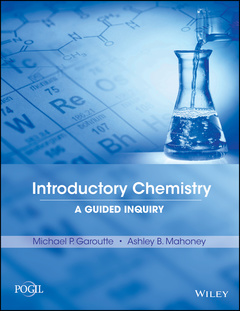Introductory Chemistry (2nd Ed.) A Guided Inquiry
Auteurs : Garoutte Michael P., Mahoney Ashley B.

ChemActivity 1 3
Working in Teams; Estimation 3
ChemActivity 2 4
Types of Matter; Chemical and Physical Changes 4
ChemActivity 3 9
Atoms and the Periodic Table 9
ChemActivity 4 14
Unit Conversions: Metric System 14
ChemActivity 5 20
Measurements and Significant Figures 20
ChemActivity 6 25
Density and Temperature 25
ChemActivity 7 29
Atomic Number and Atomic Mass 29
ChemActivity 8 34
Nuclear Chemistry 34
ChemActivity 9 40
Electron Arrangement 40
ChemActivity 10A 44
Valence Electrons 44
ChemActivity 10B 46
Electron Configuration and the Periodic Table 46
ChemActivity 11 50
Ions and Ionic Compounds 50
ChemActivity 12 54
Naming Ionic Compounds 54
ChemActivity 13 57
Covalent Bonds 57
ChemActivity 14 63
Electrolytes, Acids, and Bases 63
ChemActivity 15 67
Naming Binary Molecules, Acids, and Bases 67
ChemActivity 16 70
Molecular Shapes 70
ChemActivity 17 78
Polar and Nonpolar Covalent Bonds 78
ChemActivity 18 83
The Mole Concept 83
ChemActivity 19 87
Balancing Chemical Equations 87
ChemActivity 20A 90
Stoichiometry 90
ChemActivity 20B 93
Limiting Reagent. 93
ChemActivity 21 98
Predicting Binary Reactions 98
ChemActivity 22 102
Oxidation-Reduction Reactions 102
ChemActivity 23A 106
Equilibrium 106
ChemActivity 23B 111
Le Chatelier’s Principle 111
ChemActivity 24 114
Changes of State 114
ChemActivity 25 119
Rates and Energies of Reactions 119
ChemActivity 26 124
Gases 124
ChemActivity 27 129
Intermolecular Forces 129
ChemActivity 28 136
Solutions and Concentration 136
ChemActivity 29A 140
Hypotonic and Hypertonic Solutions 140
ChemActivity 29B 144
Colligative Properties 144
ChemActivity 30A 147
Acids and Bases 147
ChemActivity 30B 151
pH 151
ChemActivity 30C 154
Acidity Constant (Ka) 154
ChemActivity 31A 157
Buffers 157
ChemActivity 31B 160
Henderson-Hasselbalch Equation 160
ChemActivity 32 165
Titrations 165
Michael P. Garoutte received his B.S. in Chemistry from Missouri Southern State College in 1989, and his Ph. D. from the University of Kansas in 1995. His doctoral work was done under the supervision of Richard Schowen, and involved mechanistic studies of proton transfer in serine proteases. After a year teaching at Mercer University and a year at the University of Central Oklahoma, Garoutte took a position at his alma mater in 1997. He teaches a one-semester general-organic-biological chemistry course, organic chemistry, instrumental analysis, and computer applications in chemistry, and directs student research. After being introduced to Calibrated Peer Review at UCLA in 2001, Garoutte served as a facilitator for CPR and the Molecular Science project at several Multi-Initiative Dissemination Project workshops. The overwhelming community of support for curriculum reform in chemistry at these workshops encouraged him to adopt POGIL in his allied health and organic chemistry courses. He developed a set of POGIL-like guided-inquiry activities for the allied health chemistry course, published in 2007 and continues to be active in the project.
Date de parution : 08-2015
Ouvrage de 180 p.
21.6x27.4 cm
Disponible chez l'éditeur (délai d'approvisionnement : 12 jours).
Prix indicatif 65,74 €
Ajouter au panierThème d’Introductory Chemistry :
Mots-clés :
types; chemactivity; matter; estimation; physical changes; table; significant; unit; periodic; atoms; metric system; conversions; measurements; binary molecules; bases; covalent; equations; molecular; mole; chemical; concept



